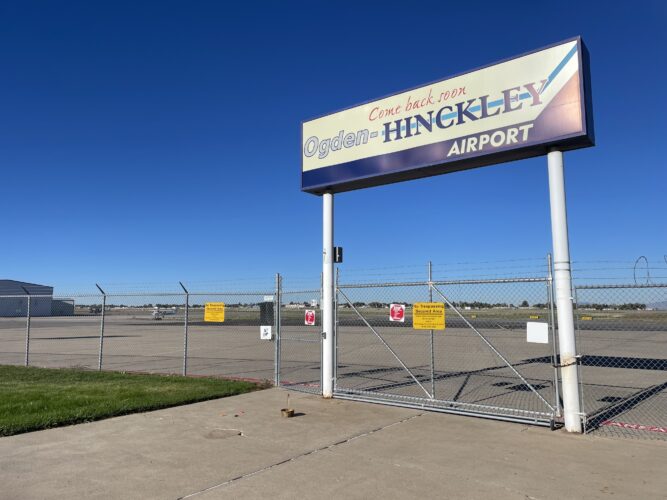GUEST OPINION: Ogden-Hinckley Airport poised for transformation: A vision of economic and aviation excellence

Tim Vandenack, Standard-Examiner file photo
A sign at a closed gate that leads to the tarmac at Ogden-Hinckley Regional Airport, photographed Thursday, Oct. 5, 2023. City officials envision major upgrades at the facility.Ogden-Hinckley Airport is on the brink of a historic transformation — an opportunity two decades in the making. Thanks to the leadership of Mayor Ben Nadolski and the Ogden City Council, change is underway that could redefine the airport as one of the community’s greatest assets.
The spark? A recent Utah state audit that pulled no punches in its assessment of past practices. For years, overly restrictive policies and cumbersome lease structures stifled growth, pushing businesses and private capital to more aviation-friendly locations. As hangar values depreciated — despite surging demand across Utah and the country — Ogden missed out on critical tax revenue.
But that trajectory is shifting fast.
A fresh wind blows at Ogden-Hinckley
With nearly 250 hangars, even modest improvements to city code and airport policy could rapidly boost property values. Many leaseholders are awaiting exactly that — an environment that rewards investment. Experts estimate tax revenues from hangar properties could quadruple if values return to just the national average.
Early signs of revitalization are already visible. Breeze Airways is providing reliable air service that residents applaud. Other airlines are expressing interest, and a new terminal now under construction is elevating the airport’s public presence. A new FAA control tower is also in the pipeline, increasing safety and operational efficiency, while the FAA has unexpectedly awarded additional funds to upgrade the southern aircraft parking ramp.
National aviation services provider AvFlight Corporation has set up operations at Ogden, delivering fueling and aircraft services. Meanwhile, Williams International is expanding its jet engine plant along the airport’s northern edge — bringing high-tech jobs and manufacturing thousands of engines for the business aviation sector.
Multiple flight schools are cultivating the next generation of pilots — both airplane and helicopter — creating viable, high-paying career paths for local youth.
And this is only the beginning.
A 2021 economic impact study estimated the airport’s contribution at $328 million annually — before many of these new developments were in motion. With the right business decisions, that figure could realistically triple.
Leadership matters: A vision for the future
Mayor Nadolski has brought the right people to the table. I had the honor of advising on the selection of our new airport director, Brian Condie — a seasoned professional with a bold and inclusive vision. His goal? To make Ogden a true “executive airport,” a term that in aviation means a thriving ecosystem for all sectors: airlines, business aviation, flight schools, private pilots and service providers alike.
It’s a vision that makes room for everyone — including community-driven programs like our local Experimental Aircraft Association chapter, which introduces youth to aviation through its “Young Eagles” flights.
Condie’s long-range vision is even more ambitious: positioning Ogden-Hinckley Airport as a gateway to the 2034 Winter Olympics. Located at the base of Utah’s Olympic venues, the airport could be a critical access point for the world stage — but only if we make it welcoming, modern and business-ready.
Nine years and counting. The clock is ticking.
National expertise, local collaboration
Condie is backed by a strong city team, including Chief Administrative Officer Mara Brown and CED Executive Director Jared Johnson. They’ve tapped into national aviation expertise, working closely with Curt Castagna, CEO of the National Air Transportation Association, and Ryan Leick of Utah Valley University.
This coalition brings unparalleled knowledge to Ogden, having invested thousands of hours over the past year in shaping a sustainable business model for the airport. Encouragingly, the City Council — led by Chair Marcia White and Vice Chair Richard Hyer — is committing to further working sessions to ensure alignment between city code and administrative flexibility.
Other cities are taking notice. Colleagues of mine across the country are watching Ogden’s progress as a potential model for revitalizing municipal airports.
The case for smart reform
A key element of progress lies in updating outdated city codes that hinder efficient airport management. For example, Ogden’s Title 8-2-4 mandates pilot qualifications that are already comprehensively governed by federal FAA regulations — making the local ordinance redundant and incomplete.
Streamlining code to focus on essential safeguards, while empowering the airport director with the flexibility to make timely business decisions, is critical. Delays caused by unnecessary legislative bottlenecks can mean missed opportunities in a competitive market.
And outdated regulations don’t stop there. Minimum standards and lease agreements in the current code carry far more serious consequences for the airport’s financial viability. Reform is essential.
Let’s seize the moment
We are at a defining moment. By staying the course, Ogden can fully unlock the potential of the Ogden-Hinckley Airport — generating jobs, attracting investment and inspiring the next generation of aviators.
I urge the community, City Council and mayor to continue this forward momentum and deliver on a vision that benefits us all.
Charlie Precourt has lived in Ogden since 2005 and operates four aircraft at Ogden-Hinckley Airport. A retired U.S. Air Force colonel and former NASA chief astronaut, he flew four space shuttle missions and spent 16 years as a VP at Northrop Grumman in Utah. He currently serves on the board of the National Business Aviation Association and as vice chairman of the Experimental Aircraft Association, working closely with the FAA on national aviation policy.

